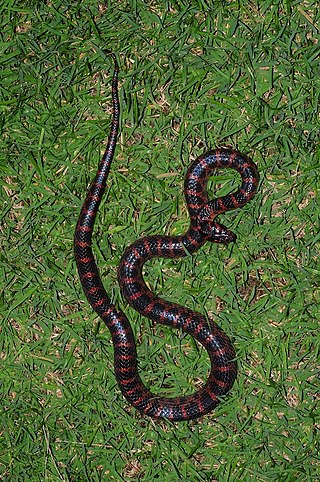Top Qs
Timeline
Chat
Perspective
Lycodon rufozonatus
Species of snake From Wikipedia, the free encyclopedia
Remove ads
Lycodon rufozonatus is a species of snake in the family Colubridae. The species is native to East Asia. It is medium-sized, nocturnal, and is considered non-venomous. Two subspecies are recognised: one of which, L. r. walli, is restricted to the Ryukyu Archipelago; the other, L. r. rufozonatus (Cantor 1842), is found only in Korea & China.[3]
Remove ads
Etymology
The subspecific name, walli, is in honor of British herpetologist Frank Wall.[4]
Description
Lycodon rufozonatus typically grows to a total length (including tail) of around 70 centimetres (28 in), reaching up to 130 cm (51 in) in extreme cases.[5] The head is long and relatively flat, and somewhat separate from the neck. The medium-sized eyes bulge slightly and have vertical pupils. The ventral scales have a strong keel, while the dorsal scales are only faintly keeled; the scale count is typically 17:17:15, but can be up to 21:19:17.[5]
Remove ads
Geographic range
Lycodon rufozonatus is found across a large part of East Asia, from the Korean Peninsula in the north (and extending just into easternmost Russia) to northern Laos and Vietnam in the south; the bulk of its range in found in eastern China.[5] The continental populations are all placed in the nominate subspecies (L. r. rufozonatus); a second subspecies, L. r. walli, is found in the Ryukyu Archipelago of southern Japan.[6]
Behaviour and ecology

Lycodon rufozonatus lives in a wide variety of habitats; it can be found from near sea level to as high as 2,000 metres (6,600 ft), and is most common near river plains.[5] It is usually found on the ground, but is occasionally seen swimming in streams.[5] It is nocturnal, feeding on fish, frogs, lizards, snakes and young birds.[5][3] D. rufozonatus has a generally mild disposition, curling into a spherical mass with the head hidden when approached. Individuals can, however, be unpredictable, and some will bite readily.[5] There are very few clinical reports on the toxinology of D. rufozonatus bites, but the species appears to be non-venomous.[5] L. rufozonatus can harbour tapeworms of the genus Spirometra, and the consumption of raw meat from D. rufozonatus has led to cases of human sparganosis in Korea and Japan.[7]
Remove ads
Reproduction
Taxonomic history
The species was first described as "Lycodon rufo-zonatus " by Theodore Edward Cantor in an 1842 paper on the fauna of "Chusan" (Zhoushan, China) in the Annals and Magazine of Natural History.[8] Cantor included it among the "innocuous" (not venomous) species, and described it as "Brown, with numerous transversal crimson bands; the abdominal surface pearl-coloured, spotted with black on the tail".[8]
Remove ads
Common names
L. rufozonatus is known by several common names, including "Asian king snake",[9] "banded red snake", "red banded krait", "red banded odd-toothed snake" and "red-banded snake".[5]
References
External links
Wikiwand - on
Seamless Wikipedia browsing. On steroids.
Remove ads


